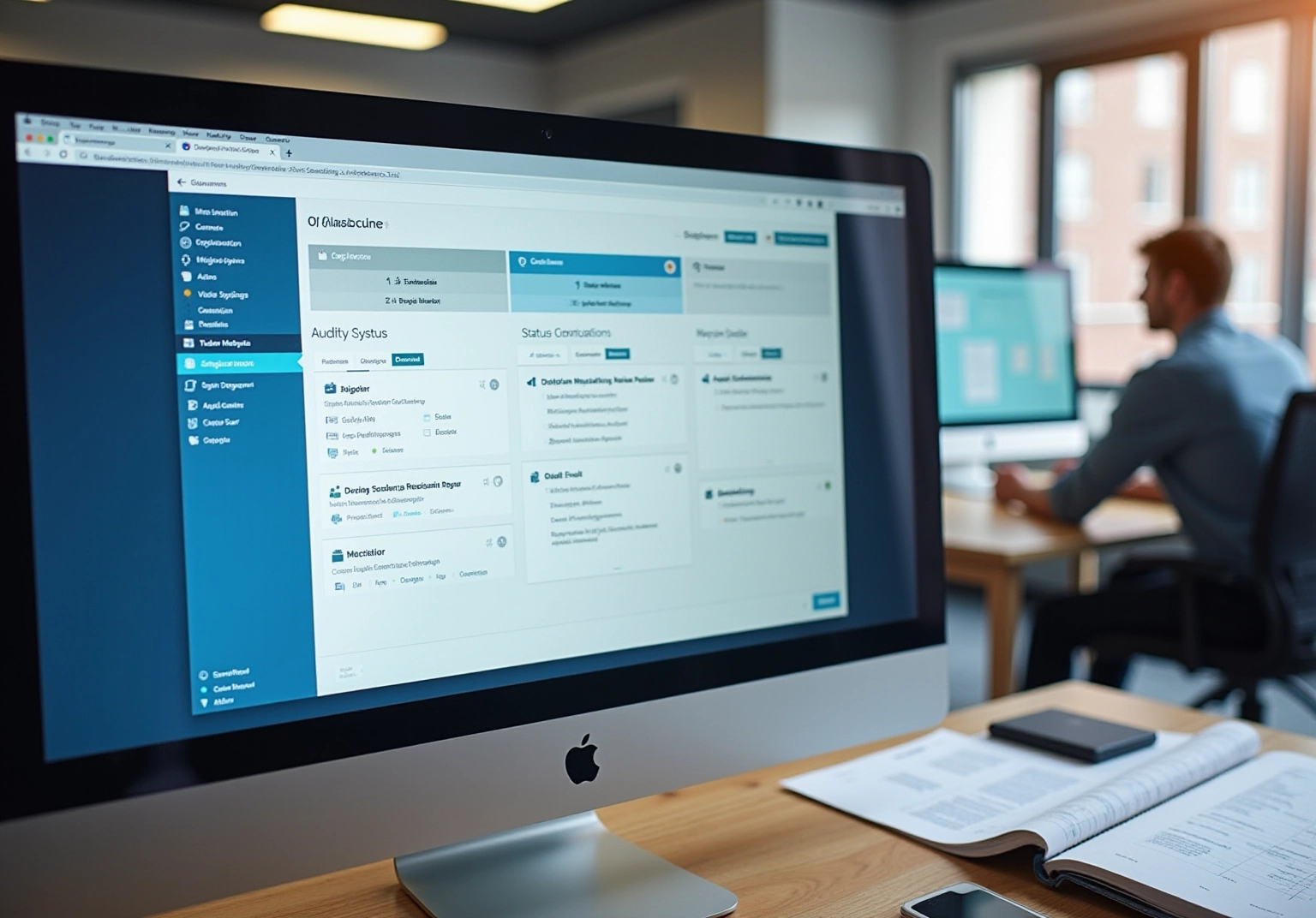Overview
This article examines the advancements and critical considerations in tax filing software for accountants in 2025, underscoring the transformative impact of technology and regulatory changes on these essential tools. Notably, software solutions such as TurboTax, H&R Block, and Glasscubes have significantly evolved, enhancing user experience and fostering client engagement. These platforms now feature AI-driven calculations and robust data protection, making it imperative for accountants to carefully evaluate their specific needs and the capabilities of available software when selecting a solution.
Key Highlights:
- In 2025, tax filing software for accountants has advanced significantly, driven by technology and regulatory changes.
- Key players in the market include TurboTax, H&R Block, Drake Software, and Glasscubes, each offering unique features.
- AI and machine learning enhance software capabilities, improving tax calculations and user experiences.
- Data protection and GDPR compliance are crucial for handling customer information securely.
- Glasscubes has improved client engagement, reporting a 40% increase in response rates and a 50% reduction in response times.
- Important criteria for evaluating tax software include features, usability, and customer support.
- Pros and cons of leading software solutions vary, with TurboTax being user-friendly but costly, and H&R Block excelling in support but lacking some advanced features.
- Recommendations for choosing software include assessing specific needs, budget considerations, and utilising trial versions.
- User reviews are essential for understanding software performance and reliability.
Introduction
In 2025, the landscape of tax filing software for accountants is witnessing a transformative shift, driven by rapid technological advancements and increased regulatory demands. This evolution not only simplifies the filing process but also significantly enhances client engagement and compliance. Leading platforms such as TurboTax, H&R Block, and Drake Software are now offering tailored solutions to meet diverse accounting needs. As accountants navigate the challenge of selecting the right software from a myriad of options, it is crucial to consider the criteria that will ensure optimal efficiency and client satisfaction.
Overview of Tax Filing Software for Accountants in 2025
In 2025, remarkable advancements have been experienced in tax filing software for accountants, driven by technological innovations and evolving regulatory demands. Accountants now benefit from a diverse array of tax filing software for accountants that not only streamline the filing process but also significantly enhance customer engagement and compliance. Leading players in the market, such as TurboTax, H&R Block, and Drake Software, present distinct features tailored to various accounting needs, ensuring firms can select the best fit for their operations. The integration of artificial intelligence and machine learning has optimised these tools, enabling more precise tax calculations and personalised user experiences.
Moreover, the emphasis on data protection and GDPR adherence has become progressively vital, guaranteeing that customer information is handled with the utmost standards of care. As accountants navigate this dynamic landscape, understanding the strengths and weaknesses of tax filing software for accountants is essential for making informed decisions that align with their practise’s goals. Notably, platforms like Glasscubes illustrate how technology can enhance customer interaction. Users report a 40% rise in customer response rates and a 50% decrease in response times. The platform automates communication and information collection, offering real-time monitoring, automated notifications, and structured replies that keep clients engaged and informed.
Sophie Montgomery from TaxAssist Accountants remarked that using Glasscubes resulted in an impressive 288 hours saved in just one tax season, showcasing the real-world impact of these advancements. This underscores the importance of leveraging innovative solutions to improve efficiency and client satisfaction in the accounting profession.
Comparison Criteria: Features, Usability, and Support
When assessing tax filing software for accountants, it is essential to consider several key criteria that can significantly influence your decision-making process.
-
Features: The software must encompass crucial functionalities such as automated tax calculations, e-filing capabilities, integration with accounting systems, and support for various tax forms. Additionally, advanced features like real-time collaboration tools and client portals can markedly enhance operational efficiency.
-
Usability: An intuitive interface is paramount, as it minimises the learning curve for users. Important factors include ease of navigation, accessibility across multiple devices, and the availability of customization options, all of which contribute to a smoother user experience.
-
Support: Dependable customer support is vital, particularly during peak tax seasons. The presence of options such as live chat, phone support, and comprehensive online resources can profoundly impact user satisfaction.
By thoroughly evaluating tax filing software for accountants against these criteria, accountants can more effectively identify the solution that best aligns with their professional needs.

In-Depth Analysis of Leading Tax Filing Software Solutions
- Glasscubes: Streamlining the Audit Process for Maximum Efficiency. As emphasised by audit manager Steve from MGI, Glasscubes significantly enhances the audit process by streamlining communication and boosting engagement with customers. In today’s fast-paced accounting environment, professionals often grapple with lengthy email chains and disjointed communication. Glasscubes addresses these challenges effectively by facilitating clear information collection, allowing users to effortlessly upload required documents and monitor pending requests. This functionality not only reduces the long email trails that often complicate audits but also fosters a collaborative environment where both clients and auditors can see the status of information requests in real-time. Key features such as automated reminders and secure file sharing further enhance a more efficient workflow, making this tax filing software for accountants an invaluable resource for accounting firms aiming to improve their audit processes. Additionally, with competitive pricing options, Glasscubes is accessible for various accounting practises, enabling firms of all sizes to elevate their audit capabilities. Consider integrating Glasscubes into your audit process to experience a transformative approach to client engagement and operational efficiency.

Pros and Cons of Each Software Solution
-
TurboTax:
- Pros: Offers a user-friendly interface, extensive resources, and live support, making it accessible for users at all levels.
- Cons: Higher cost compared to alternatives, which may not be suitable for all complex tax situations.
-
H&R Block:
- Pros: Renowned for strong customer support, making it ideal for beginners; features a comprehensive suite of tools for tax preparation.
- Cons: Some advanced functionalities may be limited when compared to competitors, potentially hindering more experienced users.
-
Drake Software:
- Pros: Provides powerful features tailored for professionals, along with excellent reporting capabilities that enhance data analysis.
- Cons: Steeper learning curve, which may overwhelm new users unfamiliar with tax applications.
-
TaxSlayer:
- Pros: Affordable pricing structure, offering essential features that cater to basic tax needs without breaking the bank.
- Cons: Lacks advanced functionalities and has limited support options, which may not meet the needs of all users.
-
FreeTaxUSA:
- Pros: Cost-effective solution that supports all major forms, with a free version available for basic tax filing.
- Cons: Limited customer support may pose challenges for users dealing with complex tax situations.
Comparison with Glasscubes:
While the aforementioned software solutions present various strengths, it is crucial to consider Glasscubes, which has demonstrated a remarkable 40% increase in client response rates for firms utilising it. This significant enhancement in communication efficiency is bolstered by its dedicated onboarding assistance, which streamlines interactions and fosters an orderly process for accounting firms.
The platform enhances the audit process by enabling accountants to request information effortlessly, resulting in faster uploads from clients compared to traditional email methods. Clients value the transparency of having all queries and outstanding information consolidated in one secure workspace, which not only improves response times but also enhances overall engagement. With Glasscubes, accountants can obtain responses from clients in half the time compared to conventional methods, making it an attractive option for those seeking to elevate their tax practise management through tax filing software for accountants.
Recommendations for Choosing the Right Tax Filing Software
When selecting tax filing software for accountants, they must consider several vital recommendations to enhance their practise’s efficiency and client satisfaction.
-
Assess Your Needs: Begin by identifying the specific features that are crucial for your practise, such as multi-state filing capabilities or tools for client collaboration. This ensures the system aligns seamlessly with your operational requirements.
-
Budget Considerations: It is essential to evaluate the cost of each application solution in relation to your budget. Consider both initial expenses and potential long-term savings derived from enhanced efficiency, particularly in light of recent economic pressures and tax policy changes.
-
Trial Versions: Take advantage of free trials or demos to assess the application’s usability and features before committing financially. This practical experience can provide invaluable insights into how effectively the programme meets your needs. For instance, this platform features an intuitive interface requiring no training, allowing accountants to engage effortlessly with trial versions. Its automated reminder feature permits unlimited, customised reminders for clients, ensuring prompt follow-ups and improved communication.
-
Client Support: Verify that the software provider offers comprehensive customer support, especially during peak tax seasons when timely assistance can significantly impact your practise’s efficiency. Look for attributes such as specialised onboarding support, which enhances communication and improves organisation. Companies utilising the platform have reported a remarkable 40% increase in client response rates and a 50% reduction in response times, underscoring the effectiveness of its solutions in transforming client engagement.
-
Flexible Subscription Options: Evaluate the available subscription plans, including the 30-day free trial, which allows you to explore its features without immediate financial commitment. This flexibility is crucial in identifying a solution that fits your practise’s needs.
-
User Reviews: Investigate user experiences and evaluations to gather insights into the programme’s performance and reliability. Positive feedback from firms using Glasscubes highlights its effectiveness in overcoming email inefficiencies and enhancing information management, ultimately contributing to a more streamlined tax preparation process.
By adhering to these recommendations, accountants can select tax filing software for accountants that not only boosts their efficiency but also enhances client satisfaction, paving the way for a more streamlined tax preparation process.

Conclusion
In 2025, the landscape of tax filing software for accountants has evolved significantly, driven by technological advancements and the need for enhanced compliance and customer engagement. The diverse range of available solutions empowers accountants to select software that aligns with their specific operational needs, ultimately streamlining the tax filing process and improving client interactions.
Evaluating software based on features, usability, and customer support is crucial. Leading platforms like TurboTax, H&R Block, and Glasscubes each offer unique benefits, from user-friendly interfaces to robust customer service. Furthermore, the integration of AI and machine learning has transformed how these tools operate, making tax calculations more accurate and user experiences more personalised. The emphasis on data protection and adherence to regulations further underscores the necessity for accountants to select software that prioritises security alongside efficiency.
As the accounting profession continues to adapt to these changes, it is essential for professionals to remain proactive in their software selection process. By assessing their specific needs, considering budget constraints, and taking advantage of trial versions, accountants can make informed decisions that enhance their practise’s efficiency and client satisfaction. Embracing innovative tax filing software not only streamlines operations but also positions firms for success in an increasingly competitive environment. Now is the time to take action and invest in the right tools that will elevate your practise and ensure compliance in the years to come.
